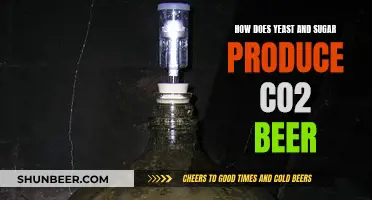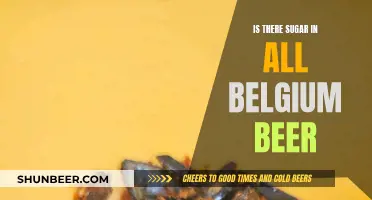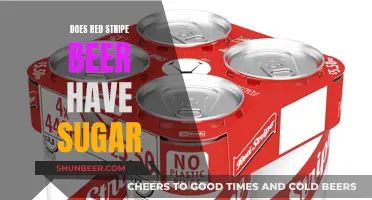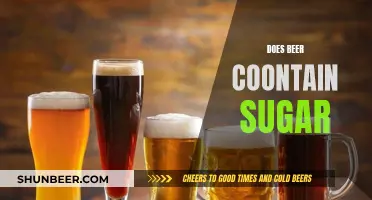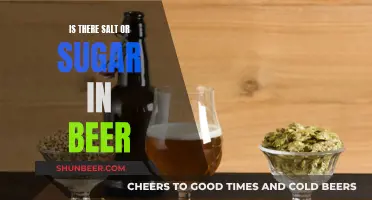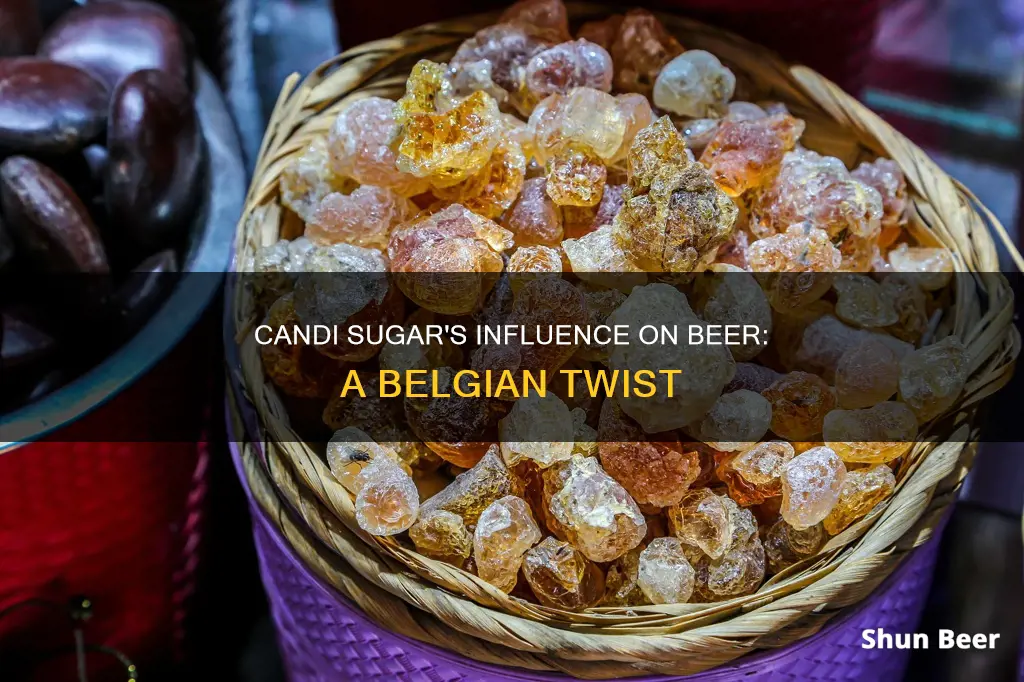
Belgian candi sugar is a key ingredient in some of the world's best, rarest, and most exotic beers. It is a type of sugar derived from beets and commonly used in brewing stronger Belgian beers, such as dubbels and tripels. Belgian candi sugar is available in various colours and forms, including rock form (a crystallized sugar) and syrup. The flavour of the sugar ranges from clean and sweet to caramel-like and toffee-like, depending on its colour. Brewers use lighter-coloured candi sugar for lighter-coloured beers and darker-coloured sugars for dark beers. The sugar is added to the beer to boost alcohol content without adding extra body and to aid in bottle conditioning and carbonation.
What You'll Learn

Belgian candi sugar is used to boost alcohol content without adding extra body to the beer
Belgian candi sugar is a sugar product commonly used in brewing beer, particularly in stronger Belgian beers such as dubbels and tripels. It is derived from sugar beets and has been subjected to the Maillard reaction and caramelization. This process converts the sucrose in the beets to a mixture of fructose and glucose, which is easier for yeast to digest.
One of the main advantages of using Belgian candi sugar in brewing is its ability to boost the alcohol content of the beer without adding extra body. This is because candi sugar is more fermentable than malt sugars, resulting in a beer with a higher alcohol content and a lighter body. Brewers often use lighter-coloured candi sugar for lighter-coloured beers, such as tripels and special golden ales, and darker-coloured sugars for dark beers, such as dubbels.
The use of Belgian candi sugar can also add subtle flavours to the beer, depending on the type and amount used. Darker candi sugars, for example, can impart flavours of high-temperature caramel, raisins, and even burnt sugar. On the other hand, lighter candi sugars have a very clean and sweet flavour that can be challenging to discern in a complex beer profile.
In addition to its flavour and alcohol-boosting properties, Belgian candi sugar is also used as a priming sugar to aid in bottle conditioning and carbonation. This versatility makes it a valuable ingredient for brewers, allowing them to adjust not only the alcohol content but also the flavour and mouthfeel of their beers.
While Belgian candi sugar offers these benefits, it is not an essential ingredient in Belgian-style beers. Some brewers may opt for simpler and more cost-effective sugar alternatives, such as corn sugar or table sugar, which can provide similar results in terms of alcohol content. Ultimately, the choice of using Belgian candi sugar depends on the brewer's preference and the specific characteristics they want to achieve in their beer.
Sweetening Success: Corn Sugar for Beer Brewing
You may want to see also

It is made from sugar beets, not sugar cane
Belgian candi sugar is made from sugar beets, not sugar cane. This is because, in Belgium, sugar is typically derived from beets, whereas, in other parts of the world, it is usually derived from sugar canes. The difference in the source of the sugar is due to the climate in Belgium, which is more suitable for growing beets than sugar canes.
Belgian candi sugar is a product of the Maillard reaction and caramelization. It is created by heating beet sugar with water in the presence of various salts, which causes the sugar to caramelize to different degrees. This process results in the distinctive dark colour and rich flavour of Belgian candi sugar.
The use of beet sugar, as opposed to cane sugar, in the production of Belgian candi sugar is important because it affects the chemical composition of the sugar. Belgian candi sugar is made up of fructose and glucose, which are easier for yeast to digest compared to sucrose, which is the main component of cane sugar. This means that Belgian candi sugar can be more easily fermented, which is important in the beer-making process.
While some people claim that the use of cane sugar in beer can leave a cider-like flavour, this is not supported by all sources. However, it is generally agreed that Belgian candi sugar, made from beet sugar, has a rich and distinctive flavour that is well-suited for use in brewing, particularly in stronger Belgian beers such as dubbels and tripels.
In summary, Belgian candi sugar is made from sugar beets, not sugar cane, due to the climate in Belgium, and this choice of raw material affects both the chemical composition and flavour of the sugar, making it a popular choice for brewers.
Pilsner Beer's Sweet Secret: Sugar Content Explored
You may want to see also

Candi sugar is used to create a range of beer colours
Candi sugar is a versatile ingredient that can be used to create a range of beer colours, from light to dark. It is made from sugar beets and has a rich, dark colour and flavour. The sugar is heated with water and some acid, which converts it from sucrose to a mixture of fructose and glucose—this process is known as inversion. The darker colours and flavours of candi sugar are achieved by heating the sugar, which causes Maillard and caramelization reactions.
The lightest forms of candi sugar add little more than gravity points to a brew, and brewers could achieve the same effect more affordably with corn sugar. However, darker, caramelised candi sugars can add distinct colours and flavours to beer. These sugars can impart flavours of smooth caramel, toffee, and raisin without the roasted quality that high dried or roasted malts can bring.
The colour of candi sugar can range from pale (1–5 SRM) to gold, amber, and dark brown, with flavours increasing along with the colour intensity. For example, the D-45 Candi Syrup is a premium amber syrup that adds flavours of toffee, vanilla, and toasted bread to amber and brown ales. The D-90 Candi Syrup is a dark syrup that creates subtle chocolate, toffee, and toasted bread flavours in dark Belgian ales. The darkest option is the Extra Dark Belgian Candi Syrup, which imparts hints of dark raisin and extra dark stone fruit, along with roasty flavours.
The different colours and flavours of candi sugar allow brewers to create a variety of beer colours and styles, from light lagers to dark Belgian ales.
Measuring Sugar Content: The Sweet Science of Beer
You may want to see also

It is easier for yeast to digest candi sugar than table sugar
Belgian candi sugar is derived from sugar beets and is commonly used in brewing stronger Belgian beers such as dubbels and tripels. It is also used as a priming sugar to aid in bottle conditioning and carbonation. Chemically, it is an unrefined sugar that has been subjected to the Maillard reaction and caramelization.
Candi sugar is a form of inverted sugar, which has been converted from sucrose to a mixture of fructose and glucose by heating with water and some acid. This process makes it easier for yeast to digest compared to table sugar, which is sucrose. Yeast can digest fructose and glucose more easily than sucrose because they do not need to take an additional step of creating an enzyme to break down the sucrose first.
The use of candi sugar in brewing can boost the alcohol content of the beer without adding extra body or forcing the yeast to produce invertase. It results in a beer with a lighter body and higher alcohol content because it is more fermentable than malt sugars. This is one reason why many Belgian beer styles are notably drier than most beers from other countries.
The flavour of candi sugar can vary from very clean and sweet at the light end to very caramel-like and toffee-like at the dark end. The darker-coloured sugars are used in dark beers such as dubbels, where they give flavours of high-temperature caramel, raisins, and even burnt sugar. Brewers often use the lighter-coloured candi sugar for lighter-coloured beers such as tripels and special golden ales.
Nonalcoholic Beer: Sugar Content and Health Benefits Explored
You may want to see also

Candi sugar is used to make beer more drinkable
Candi sugar is a Belgian sugar product commonly used in brewing beer, especially in stronger Belgian beers such as dubbels and tripels. It is an unrefined sugar beet-derived sugar that has been subjected to the Maillard reaction and caramelization. This process creates a sugar that is easier for yeast to digest, which in turn makes the beer lighter in body and higher in alcohol content. This is why many Belgian beer styles are notably drier and more drinkable than most types from other countries.
The flavour of candi sugar can range from very clean and sweet to very caramel-like and toffee-like, depending on the degree of caramelization. The lightest Belgian candi sugars will impart virtually no flavour and are essentially just an expensive form of simple sugar. However, the amber and dark candi sugars will impart subtle but noticeable flavours when used in sufficient quantities. These flavours can include smooth caramel, toffee, raisin, date, chocolate, and even light citrus notes.
The use of candi sugar in beer can also aid in bottle conditioning and carbonation. In addition, the sugar can be used to lighten the body of the beer, making it more drinkable. This is especially useful in traditional Belgian strong ales, where a high ABV is desired without the accompanying heaviness.
Ultimately, the specific impact of candi sugar on the drinkability of a beer will depend on the type of candi sugar used, how it is used, and in what quantities. Brewers can experiment with different colours and amounts of candi sugar to find the perfect balance for their desired level of drinkability.
Beer vs Jack: Which Drink Has More Sugar?
You may want to see also
Frequently asked questions
Belgian candi sugar is a sugar product commonly used in brewing beer. It is made from sugar beets and has been subjected to the Maillard reaction and caramelization.
Belgian candi sugar boosts the alcohol content of beer without adding extra body. It also aids in bottle conditioning and carbonation.
Belgian candi sugar is used in stronger Belgian beers such as dubbels and tripels. It is also used in amber and brown Belgian ales.
The flavour of Belgian candi sugar ranges from very clean and sweet to very caramel-like and toffee-like. It can also give flavours of high-temperature caramel, raisins, and even burnt sugar.



